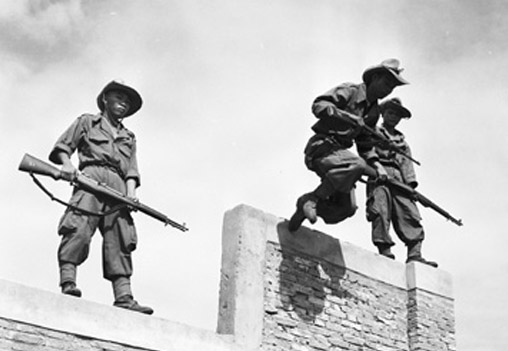|
M1 Garand |
|
|
|
Garand's rifle was originally chambered for the .276 Pedersen cartridge, charged by means of 10-round clips. Later, it was chambered for the then-standard .30-06 Springfield. With this new cartridge, the Garand had a maximum effective range 450 m, with the capability of inflicting a casualty with armor-piercing ammunition well beyond 800 m. Because of the larger diameter of the .30-06 cartridge, the reworked magazine design held only eight rounds instead of ten. The weight of the M1 varies between 4.31 kg and 4.63 kg unloaded (depending on sling type and stock wood density), a considerable increase over the previous M1903 Springfield. The length was 1,107 mm. The rifle is fed by an "en bloc" clip which holds eight rounds of .30-06 Springfield ammunition. When the last cartridge is fired, the rifle ejects the clip and locks the bolt open. Clips can also be manually ejected at any time. The "en bloc" clip is manually ejected by pulling the operating rod all the way to the rear, and then depressing the clip catch button. Other than weight, the clip-feeding system of the Garand was the most-criticized feature of the rifle, which made it difficult to reload partially expended clips, and its use was not continued in later firearms designs. By modern standards, the M1's feeding system is archaic, relying on clips to feed ammunition, and is the principal source of criticism of the Garand rifle. Officials in Army Ordnance circles demanded a fixed, non-protruding magazine for the new service rifle. At the time, it was believed that a detachable magazine on a general-issue service rifle would be easily lost by U.S. soldiers (a criticism made of British soldiers and the Lee-Enfield 50 years previously), would render the weapon too susceptible to clogging from dirt and debris (a belief that proved unfounded with the adoption of the M1 Carbine), and that a protruding magazine would complicate existing manual-of-arms drills. As a result, inventor John Pedersen developed an "en bloc" clip system that allowed ammunition to be inserted from above, clip included, into the fixed magazine. While this design provided the requisite flush-mount magazine, the clip system increased the rifle's weight, and prevented it from being fired without a clip, such as while reloading. The rifle's ability to rapidly fire powerful .30-06 rifle ammunition also proved to be of considerable advantage in combat. In China, Japanese banzai charges had previously met with frequent success against poorly-trained Chinese soldiers armed with bolt-action rifles. However, armed with the Garand, U.S. Infantrymen were able to sustain a much higher rate of fire than their Chinese counterparts. In the short-range jungle fighting, where opposing forces sometimes met each other in column formation on a narrow path, the penetration of the powerful .30-06 M2 cartridge enabled a single U.S. infantryman to kill up to three Japanese soldiers with a single round. The M1 was used heavily in World War II, the Korean War, and, to a limited extent, in the Vietnam War. Most M1 rifles were issued to American troops, though many were lent to other nations. French troops in Indochina used this gun in limited numbers, mostly by North african units and late in the war by new units of the L'armée nationale viêtnamienne (Vietnamese National Army - ANV).
|
|
|

